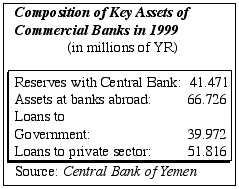
Saving, Investment and Economic Growth Part 3/3 [Archives:2001/07/Business & Economy]
February 12 2001
By: Dr. Alexander Bohrisch
Dr. Alexander Bohrisch is currently with GTZ (German Technical Cooperation), Sana’a Office until June 2001. Before, he has been a senior staff member of the United Nations Conference on Trade and Development (UNCTAD), Geneva, Switzerland. The views expressed in this article are those of the author and do not necessarily reflect those of GTZ.
Whereas both saving and investment rates in Yemen are somewhat higher than in many other less developed countries (although eventually not sufficient for sustained increase in per capita income due to demographic pressures), the role of the financial system in translating savings into investment is inadequate. An indication for the low financial depth are the ratios of money supply (M2) to GDP and of domestic credit provided by the banking sector to GDP. For 1999 these ratios were at 33.6% and 22.1% respectively.
Low financial depth tends to deteriorate the productivity of investment and involves the risk that sub-optimal projects are financed thus constraining economic growth.
There are a host of reasons which explain the low financial depth/intermediation in Yemen. Many Yemenis do not use banks for saving and investment purposes. Banks exist only in the major cities and there is a tendency among many Yemenis, particularly in rural areas, to keep savings at home. Furthermore, eventually high real interest rates had a negative effect on investment.
However, very important is the fact that banks hesitate to lend money to creditors because of the risk of non-performing loans and the difficulty and time consuming enforcement of loan contracts in default. Information about loans to the private sector are available from the consolidated balance sheet of the commercial banks. Loans to the private sector accounted for only a quarter of banks’ total assets in 1999. They corresponded to only 4.9% of GDP in 1999.

This low share takes on an even more critical importance when the distribution of loans across sectors and the duration and type of loans is taken into account. In 1999, almost 42% of loans to the private sector were used for import/export and domestic trade financing, which were largely short term loans and advances. Some 20% of loans went to industry, construction and agriculture, about half of which was in the form of short term loans and advances. A mere 12% were medium and long term credits for financing investment projects in industry, construction and agriculture. In addition, only a few larger firms benefit from bank financing while the large number of smaller companies have only limited access to bank credits. In this connection it has to be noted that investments in raw material exploration projects are almost entirely financed through foreign direct investment and not by national savings.
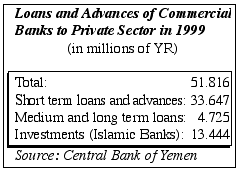
The above findings have important implications for the development prospects of the country in general and for the growth of the small and medium sized industry in particular (including the success of technical assistance projects in the widest sense provided directly or indirectly to this sector of the economy). The availability of credits at competitive terms is one crucial factor for the development of industry given its low capital basis. To the extent that credits for private investments are only available in a very limited way, the development of industry will be negatively affected which is confirmed by the modest growth rate of the manufacturing industry during the last years.
Regarding the structure of deposits the high share of foreign currency deposits in M2 (dollarization ratio) has to be noted. It shows that many Yemeni savers still have little trust in their own currency.
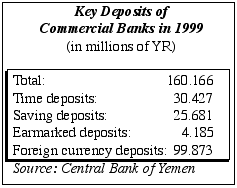
In 1997, real interest rates on YR deposit accounts turned positive for the first time in years. During the years when real interest rates on YR deposit accounts were positive, they were, for most periods, also higher than real interest rates on foreign currency deposit accounts. In spite of this, many Yemenis saved in foreign currency deposit accounts, obviously because of the lingering risk of a higher than expected depreciation of the YR vis-a vis the US$ than covered by the interest rate differential between domestic currency and foreign currency deposits.
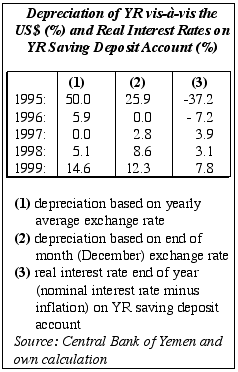
The dollarization ratio in Yemen has been 29.4 % in 1999 as compared to 22.4 % in 1995. Although it has been increasing over the last 5 years, the pace of dollarization seems to have weakened in 1999. Dollarization occurs at times of high and volatile inflation and when there is a risk of a depreciation of the currency. Experience shows that success in containing inflation and/or in stabilizing the exchange rate is not rapidly rewarded by a full shift from foreign currency into local currency assets.
Dollarization has the positive result that citizens dispose of a reliable store of value and that it may halt the outflow of capital. Also, agents tend to hold deposits in the banking system and financial deepening is strengthened. On the other hand, strong dollarization may expose a country to the risk in financial and foreign exchange markets and may hinder monetary policies if the foreign currency component of the money supply cannot be controlled by the monitory authority.
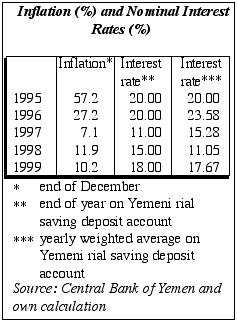
The World Bank and the IMF have stressed i.a. the urgent need for improving financial intermediation. In recent years, Yemen has been successful in improving its macroeconomic policies by containing inflation, reducing the budget deficit and striving to stabilize the exchange rate; but in order to fully reap the fruits of these efforts, it is of basic importance that the banking sector plays its proper role in the matching mechanism between saving and investment and that the judiciary system provides adequate security for banks in the provision of credit to the private sector. By and large, it is less foreign grants but principally private investment – whether domestic or foreign – which is the engine for diversifying exports away from oil and thus helping to stimulate economic growth, reduce unemployment and put development on a broader basis.(End)
——
[archive-e:07-v:2001-y:2001-d:2001-02-12-p:./2001/iss07/b&e.htm]


